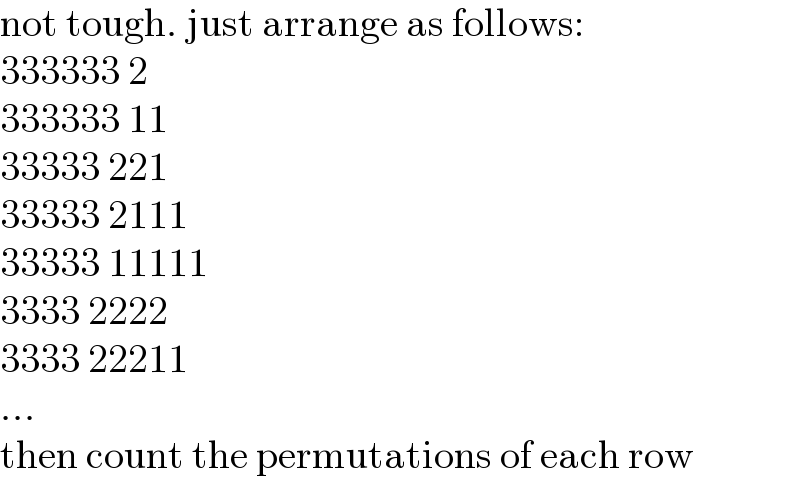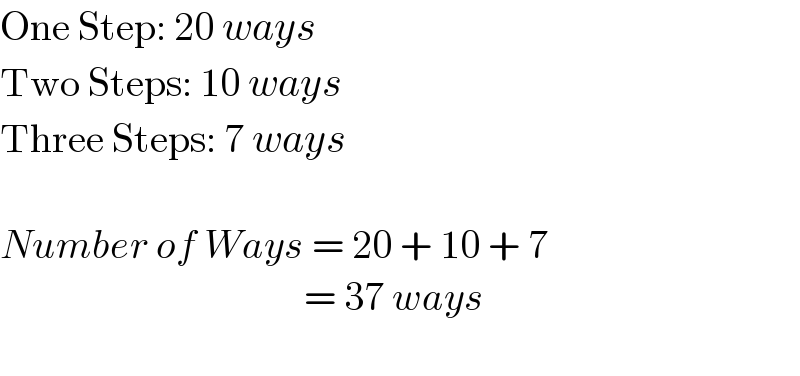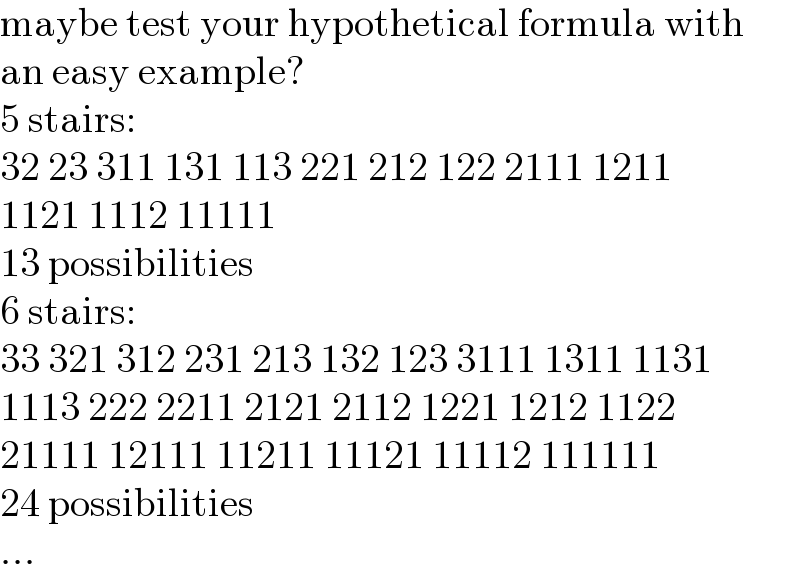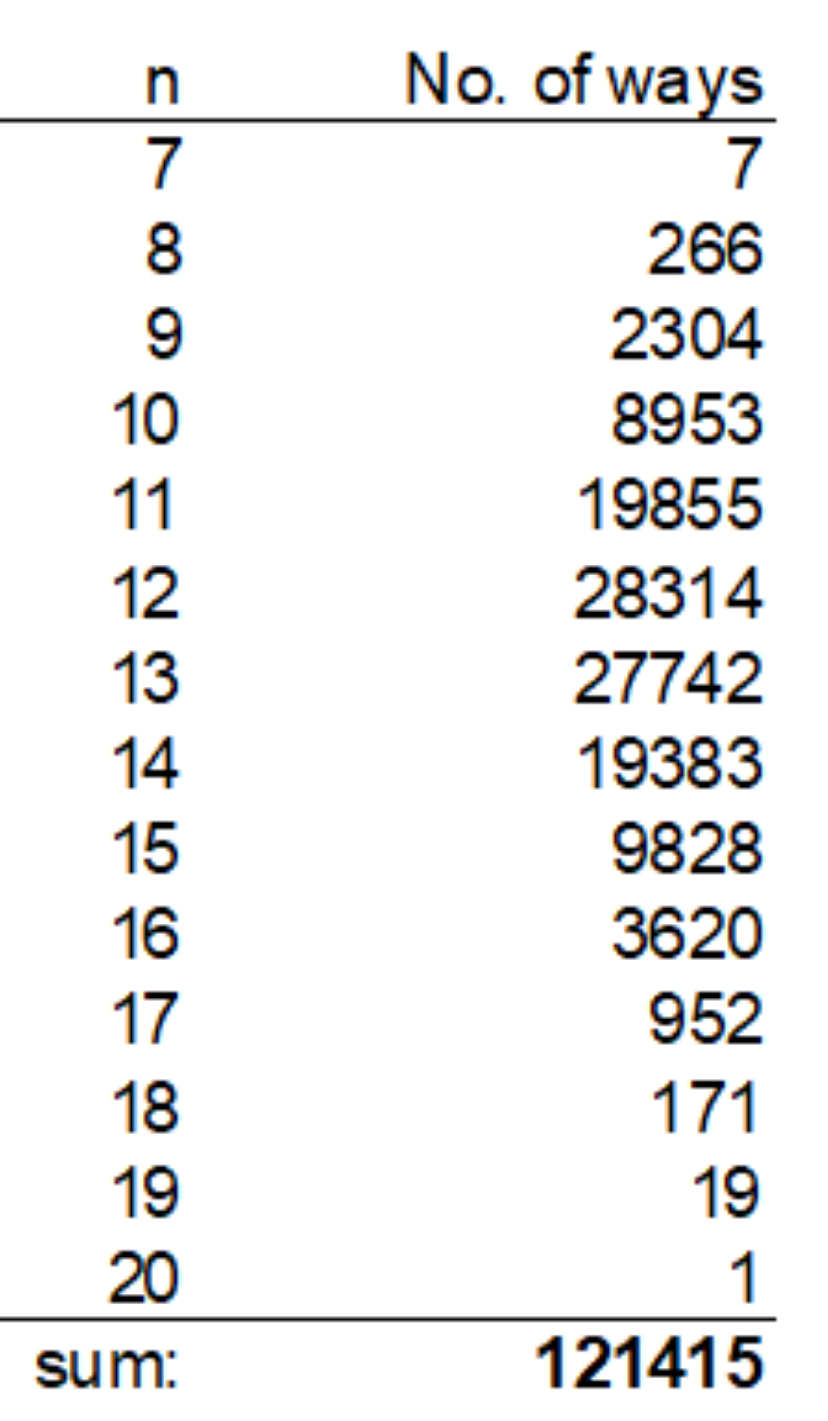Question Number 166770 by mr W last updated on 27/Feb/22

Commented by MJS_new last updated on 27/Feb/22

Commented by mr W last updated on 28/Feb/22

Commented by peter frank last updated on 28/Feb/22

Commented by MJS_new last updated on 28/Feb/22

Commented by mr W last updated on 28/Feb/22

Commented by MJS_new last updated on 28/Feb/22

Answered by nadovic last updated on 27/Feb/22

Commented by mr W last updated on 27/Feb/22

Answered by nadovic last updated on 28/Feb/22

Commented by MJS_new last updated on 28/Feb/22

Answered by mr W last updated on 01/Mar/22

Commented by mr W last updated on 28/Feb/22

Commented by Tawa11 last updated on 28/Feb/22

Answered by mr W last updated on 02/Mar/22
![AN OTHER METHOD let′s say there are N(n) ways to go up a staircase with n steps. if we make a move with one step, then there are n−1 steps remaining and there are N(n−1) ways to go up the remaining steps. if we make a move with two steps, then there are n−2 steps remaining and there are N(n−2) ways to go up the remaining steps. similarly if we make a move with three steps, then there are N(n−3) ways to go up the remaining steps. therefore we have following recurrence relation: N(n)=N(n−1)+N(n−2)+N(n−3) we also have N(1)=1 N(2)=2 N(3)=4 applying the recurrence relation above, we get N(4)=7 N(5)=13 N(6)=24 N(7)=44 N(8)=81 N(9)=149 N(10)=274 N(11)=504 N(12)=927 N(13)=1705 N(14)=3136 N(15)=5768 N(16)=10609 N(17)=19513 N(18)=35890 N(19)=66012 N(20)=121415 ✓ we can also find a closed formula for N(n) by solving following characteristic equation λ^3 −λ^2 −λ−1=0 let λ=s+(1/3) s^2 −(4/3)s−((38)/(27))=0 with u=((3(√(33))+19))^(1/3) , v=((3(√(33))−19))^(1/3) λ_1 =(1/3)(1+u−v) λ_(2,3) =(1/6)[2−u+v±(√3)(u+v)i] ⇒N(n)=Aλ_1 ^n +Bλ_2 ^n +Cλ_3 ^n N(0)=N(3)−N(2)−N(1)=1 N(−1)=N(2)−N(1)−N(0)=0 N(1)=Aλ_1 +Bλ_2 +Cλ_3 =1 N(0)=A+B+C=1 N(−1)=(A/λ_1 )+(B/λ_2 )+(C/λ_3 )=0 [(λ_1 ,λ_2 ,λ_3 ),(1,1,1),((1/λ_1 ),(1/λ_2 ),(1/λ_3 )) ] ((A),(B),(C) ) = ((1),(1),(0) ) ⇒ ((A),(B),(C) ) = [(λ_1 ,λ_2 ,λ_3 ),(1,1,1),((1/λ_1 ),(1/λ_2 ),(1/λ_3 )) ]^(−1) ((1),(1),(0) )](https://www.tinkutara.com/question/Q166880.png)
